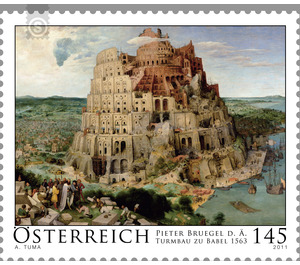Old Masters - Austria / II. Republic of Austria 2011 - 145 Euro Cent
Theme: Art & Culture
| Country | Austria / II. Republic of Austria |
| Issue Date | 2011 |
| Face Value | 145.00 |
| Edition Issued | 250,000 |
| Printing Type | combination printing |
| Stamp Type | Commemorative |
| Item Type | Stamp |
| Chronological Issue Number | 2274 |
| Chronological Chapter | OOS-OE2 |
| SID | 884006 |
| In 56 Wishlists | |
Pieter Bruegel the Elder, one of the most important painters of the Dutch Renaissance, was best known for his portrayals of peasant life in the Duchy of Brabant (Flanders) in the 16th century. Not much is known about the life of this old master, only a few key data can be said with certainty: Bruegel was a student of the Antwerp artist Pieter Coecke van Aelst and then worked in a copper workshop. During a trip to Italy between 1552 and 1555, in which the landscape depiction was already a focal point of his work, he lived from 1553 for some time in Rome, where he worked for the miniature painter Giulio Clovio. Then he returned to Antwerp, married and finally settled in Brussels. After his death on 5 September 1569 Pieter Bruegel was buried in the church Notre Dame de la Chapelle. Bruegel's idiosyncratically typical style can only be described inadequately with a stylistic term. One of his great role models was Hieronymus Bosch, whose pictorial language he skillfully cited, especially in his earlier works. Flemish landscape painting of the 16th century, of course, brought Bruegel to its zenith; He founded the Dutch peasant genre and created numerous allegorical works that refer to various proverbs and folk culture in an artistic way. The Tower of Babel is undoubtedly one of Pieter Bruegel the Elder's most famous paintings. Shown is the company of men described in Genesis, to build a tower "whose apex reaches to the sky". The immense size of the building, the labor and the construction technique used are the main contents of this work of art, but the surrounding landscape is obviously influenced by the Flanders nature - in the distance you can see the sea, the mountains and the walled city of Antwerp remembering city that lies behind the tower. Most of the people portrayed in the painting, above all craftsmen and stonemasons, are tiny, but the owner, King Nimrod and his entourage, are much larger. The kowtowing that stonemasons perform before him indicates the oriental roots of history. The imposing image, according to the interpretation, is regarded as an indication of the transience of all earthly things and the futility of any human endeavor to imitate God as Creator.


